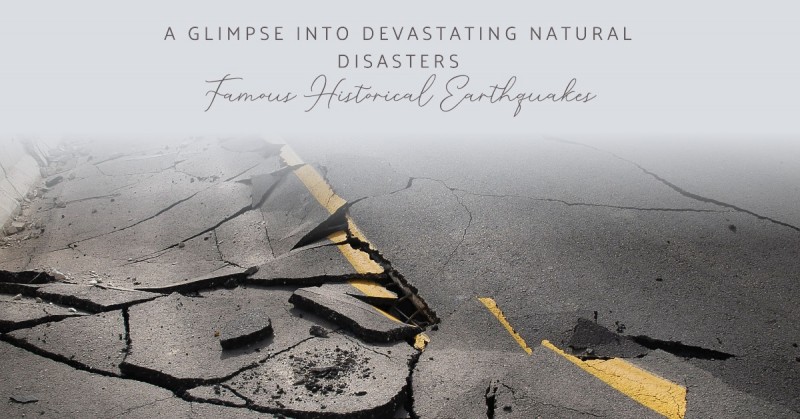
Earthquakes are powerful and destructive natural phenomena that have shaped the course of history. Throughout time, numerous significant earthquakes have occurred, leaving indelible marks on the affected regions and their inhabitants. This article delves into three famous historical earthquakes, namely the 1906 San Francisco earthquake, the 2011 Tohoku earthquake and tsunami in Japan, and the 2010 Haiti earthquake. Each of these seismic events had a profound impact on their respective regions, causing widespread destruction and loss of life.
The 1906 San Francisco Earthquake
The 1906 San Francisco earthquake, also known as the Great San Francisco earthquake, struck the city on April 18, 1906. With an estimated magnitude of 7.8, this earthquake caused widespread devastation and remains one of the most significant seismic events in American history.
Impact and Destruction
The shaking of the earth during the 1906 San Francisco earthquake resulted in the collapse of buildings, fires, and significant loss of life. It is estimated that around 3,000 people lost their lives, and more than 80% of the city was destroyed or damaged. The subsequent fires that broke out due to ruptured gas mains exacerbated the destruction, leaving a lasting impact on the city and its residents.
Rebuilding San Francisco
After the earthquake, the city of San Francisco embarked on a massive reconstruction effort. The rebuilding process aimed to make the city more resilient to future earthquakes. The introduction of stricter building codes and seismic regulations became an integral part of the city's development, ensuring the safety of its inhabitants.
The 2011 Tohoku Earthquake and Tsunami
On March 11, 2011, Japan experienced a devastating earthquake with a magnitude of 9.0. This powerful seismic event triggered a massive tsunami that engulfed the northeastern coast of Japan, leaving a trail of destruction and loss.
Tsunami Devastation
The Tohoku earthquake resulted in a colossal tsunami, with waves reaching heights of up to 40 meters (131 feet). The destructive force of the tsunami swept away entire towns, causing immense damage and claiming the lives of approximately 15,000 people. The nuclear disaster at the Fukushima Daiichi power plant further compounded the catastrophe.
Reconstructing Tohoku
In the aftermath of the disaster, Japan mobilized its resources to rebuild the affected regions. The reconstruction efforts focused not only on physical infrastructure but also on addressing the emotional and psychological scars left by the earthquake and tsunami. The resilience and unity of the Japanese people played a crucial role in the recovery process.
The 2010 Haiti Earthquake
Haiti, a small Caribbean nation, experienced a catastrophic earthquake on January 12, 2010. With a magnitude of 7.0, this earthquake had devastating consequences for the already impoverished country.
Widespread Destruction
The Haiti earthquake caused widespread destruction, as the country's infrastructure was ill-prepared to withstand such a powerful tremor. Buildings, including hospitals and schools, crumbled under the force of the quake, resulting in the loss of approximately 230,000 lives and displacing millions of people.
Challenges and Rebuilding Efforts
Recovering from the Haiti earthquake posed immense challenges due to the country's limited resources and fragile political situation. The international community rallied together to provide aid and support, contributing to the reconstruction efforts. However, the process has been slow and hindered by various obstacles, emphasizing the need for long-term sustainable solutions.
Comparing the Three Earthquakes
Although occurring in different regions and time periods, the 1906 San Francisco earthquake, the 2011 Tohoku earthquake and tsunami, and the 2010 Haiti earthquake share some similarities and differences.
In terms of similarities, all three earthquakes caused widespread destruction, resulted in a significant loss of life, and required extensive rebuilding efforts. The devastation inflicted by these seismic events highlights the vulnerability of communities to such disasters.
However, there are also notable differences among these earthquakes. The levels of preparedness, infrastructure resilience, and socio-economic factors played crucial roles in the varying degrees of impact and recovery. The San Francisco earthquake spurred the development of seismic regulations, whereas Japan's experience with earthquakes led to advanced engineering and early warning systems. Haiti, unfortunately, faced challenges in rebuilding due to its limited resources and political instability.
Recovery and Rebuilding Efforts
In the wake of these catastrophic earthquakes, recovery and rebuilding efforts played vital roles in restoring normalcy to the affected regions. Governments, NGOs, and local communities worked together to rebuild infrastructure, provide healthcare, and support those who lost their homes and loved ones.
The Importance of Community Support
One common thread in all three cases is the power of community support and resilience. Communities came together to provide assistance, share resources, and rebuild their lives. The unity and determination displayed by the affected populations were instrumental in the recovery process.
Lessons Learned
The historical earthquakes discussed in this article have left behind valuable lessons for individuals, communities, and governments worldwide. Some of the key lessons include:
Conclusion
Historical earthquakes such as the 1906 San Francisco earthquake, the 2011 Tohoku earthquake and tsunami, and the 2010 Haiti earthquake serve as powerful reminders of the unpredictable and devastating nature of seismic events. These earthquakes have had far-reaching impacts on the affected regions and have shaped disaster preparedness and recovery efforts.
While the scars of these disasters remain, they also demonstrate the strength and resilience of human communities. Through learning from past experiences and implementing robust measures, we can strive to minimize the impact of future earthquakes and protect the lives and livelihoods of those at risk.
Henadi Al-Saleh: Saudi Arabia's rapidly expanding logistics sector is driving regional change
NATO launches a historic air exercise as a "show of strength"